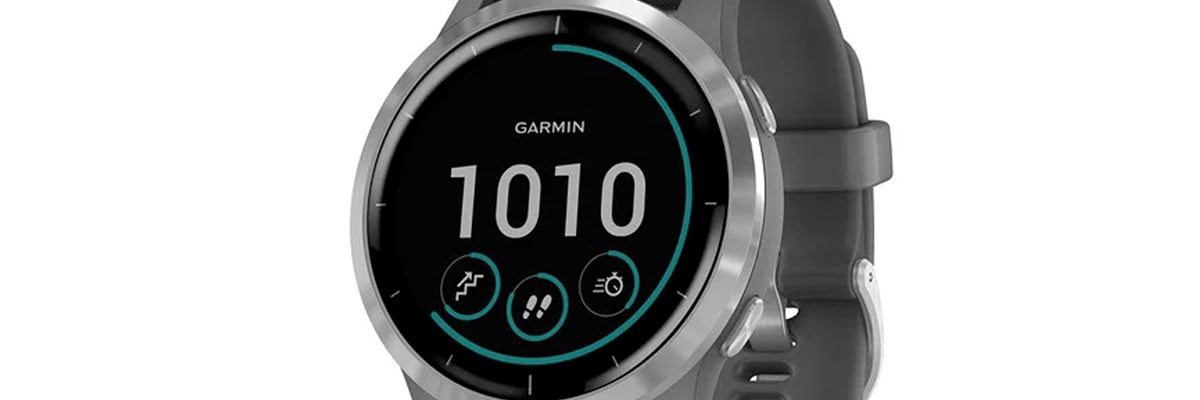
Return navigate_next
Garmin Vivoactive 4: A Fitness-Focused Smartwatch
October 12, 2021 *
Garmin’s Vivoactive 4 is an interesting beast. First released in 2019, this wrist-worn device is both a lightweight smartwatch and a high-end GPS-enabled fitness tracker. It sits at a price point comparable to the latest Galaxy Watch and around the Apple Watch SE, and it can simultaneously do way more and way less than those devices.
In this review, learn what the Garmin Vivoactive 4 is exactly, plus why you might (or might not) want to get one. And if you do get one, don’t forget to pick up an extended warranty for your new piece of gear.
Garmin Vivoactive 4: What Is It?
The first and most important question about this device is probably this: what exactly is it? At a glance, the Vivoactive 4 looks like an oversized smartwatch. And it is, kind of. But it’s also a very capable fitness tracker, with a feature set more in line with a dedicated fitness device than a smartwatch.

Garmin (now owned by Google) calls the device a fitness tracker/smartwatch hybrid, which is probably the best term for it. All smartwatches offer some fitness features, of course. But this device offers far, far more on the fitness front.
If there’s a spectrum with productivity and communication tools on one end and fitness tracking on the other, major smartwatches lean toward the former. The Garmin Vivoactive 4 is on the other end, heavily weighted toward fitness tracking with less of a focus on “smartwatch stuff.”
Excellent, Multi-Day Battery Life
One big point of differentiation is battery life. Garmin Vivoactive 4 will last days, not hours — up to 8 days in smartwatch mode (not actively using GPS). PC Mag’s reviewer got around 4 days of real-world use (including several fitness activities).
Compare that to the Apple Watch, which rarely lasts more than a day in real-world use, and the Vivoactive 4 is looking pretty good.
A Deep Bench of Fitness Features
The star of the show here, of course, is the deeply impressive roster of fitness features. The watch is preloaded with 20 exercise types, and you can add more from the store. The GPS functions are especially valuable for runners. You can create custom training plans on your computer and push them to the Vivoactive 4, as well.
The large and vivid display can also serve up on-screen yoga, cardio and even strength training workouts, complete with animations showing you proper form. There’s also health and sleep tracking, including pulse oximeter functions.

Garmin Vivoactive 4 Is Also a Smartwatch
While the device is certainly more similar to a fitness tracker than a smartwatch, it does have enough smart capabilities to qualify as the latter. Just don’t expect the kind of deep integration and powerful functionality you’d get from an Apple Watch.
The watch isn’t running any recognizable mainstream OS. Installing apps on the watch can only happen through the accompanying smartphone app, and it’s not very smooth. Selection is limited, as is functionality within those apps. You can’t call or text from it, either.
But you can load up to 500 songs on here (including downloads from Amazon Music and other streamers). You can add a credit card and use Garmin Pay anywhere that accepts NFC payments. You can do basic smartwatch stuff, but that’s about it.
Who Should Purchase the Garmin Vivoactive 4?
The last big question about the Garmin Vivoactive 4 is this: who exactly is it for?
If smartwatch features are the main reason for spending $300 to $400 for something that goes on your wrist, you probably aren’t the target market here. It’s a passable smartwatch experience at best (and only if you’re OK with a smartwatch that can’t text or call anyone).
If you need only basic fitness tracking features, this device is massive overkill. Your smartphone alone might be good enough, or a $99 “dumb” tracker will certainly do what you need.
So who is in the target market here? Sports and fitness enthusiasts who need more than they could get out of their phone or from a mainstream smartwatch. If you’re serious about your fitness routine — or you just exercise in a form that WatchOS and Wear OS can’t track — you need a better fitness tracker. And if you’re going to wear it on your wrist, you may as well make it smart.
If the preceding description appeals to you, then you’ll love the Vivoactive 4. If not, your mileage may vary.

Picking up a Vivoactive 4? Add an Upsie Extended Warranty Now
For the fitness-minded (or even those who prefer a lighter-weight smartwatch experience that lasts multiple days on a charge), the Vivoactive 4 is an interesting, even compelling, option. It may lack the polish and deep integrations of the Apple Watch, but the wide set of fitness features and longer battery life are aspects Apple can’t match.
If you’re picking up a Garmin Vivoactive 4 anytime soon, you should pair it with an Upsie extended warranty. When using a smartwatch daily, you expose the watch to potential damage. And even though it’s built to withstand damage, there’s always a chance it could fail.
With an Upsie extended warranty, you’re protected from accidental damage, manufacturers defects, and internal failures. In addition, Upsie allows you to make unlimited claims up to the purchase price of the device. And Upsie plans are more affordable than you might think. Upsie’s warranties are up to 70 percent less expensive than warranties from other companies.
You can purchase an Upsie warranty within 60 days of buying your smartwatch. Before you head out on your next run (or whatever activity you prefer), protect your new Vivoactive 4 with Upsie.
Learn More About Smartwatches:
* This article is over 6 months old and may or may not be updated.
